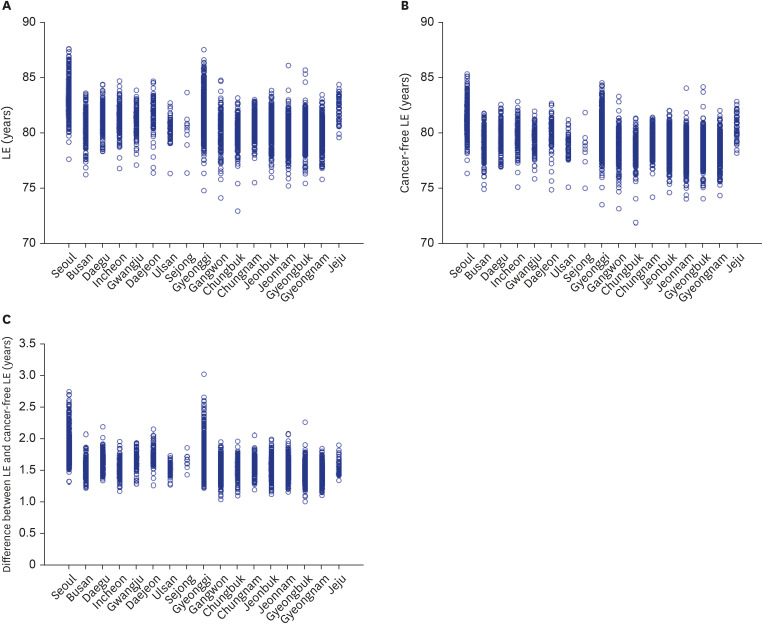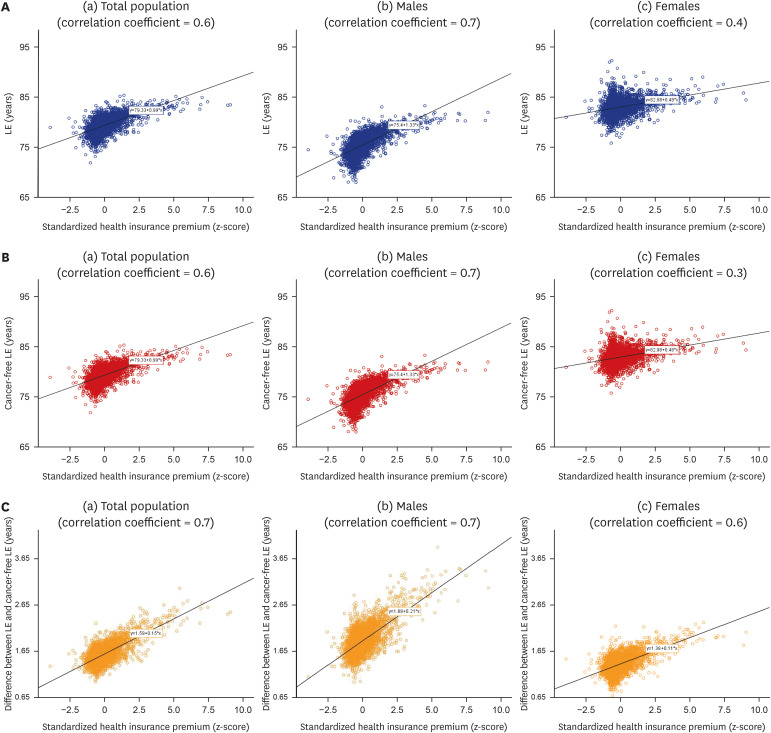1. Kim BR, Yoon TH. The association between socioeconomic deprivation and life expectancy and healthy life expectancy by region in Korea. Korean J Health Educ Promot. 2017; 34(5):29–40.

3. Khang YH, Yun SC, Bahk J, Kang HY, Kim I, Seo S. Developing Indicators for Evaluating and Monitoring the Health Plan 2020 Using the National Health Information Database of the National Health Insurance Service in Korea. Seoul, Korea: Korea Health Promotion Institute;2016.
4. Yang S, Khang YH, Harper S, Davey Smith G, Leon DA, Lynch J. Understanding the rapid increase in life expectancy in South Korea. Am J Public Health. 2010; 100(5):896–903. PMID:
20299661.

5. Byun YC, Lee SK, Park SJ, Lee MK. Regional Differences in Health Expectancy in Korea and Policy Suggestions. Seoul, Korea: Korea Institute for Health and Social Affairs;2011.
6. Lee JY, Ock M, Kim SH, Go DS, Kim HJ, Jo MW. Health-adjusted life expectancy (HALE) in Korea: 2005–2011. J Korean Med Sci. 2016; 31(Suppl 2):S139–S145. PMID:
27775251.

7. Kwon TY, Lim JY, Park Y. Health life expectancy in Korea based on sample cohort database of National Health Insurance Services. Korean J Appl Stat. 2017; 30(3):475–486.

8. Jo MW, Seo W, Lim SY, Ock M. The trends in health life expectancy in Korea according to age, gender, education level, and subregion: using quality-adjusted life expectancy method. J Korean Med Sci. 2018; 34(Suppl 1):e88. PMID:
30923491.

9. Ock M, Han JW, Lee JY, Kim SH, Jo MW. Estimating quality-adjusted life-year loss due to noncommunicable diseases in Korean adults through to the year 2040. Value Health. 2015; 18(1):61–66. PMID:
25595235.

10. Korea Central Cancer Registry, National Cancer Center. Annual Report of Cancer Statistics in Korea in 2017. Goyang, Korea: Korea Central Cancer Registry, National Cancer Center;2019.
12. Fitzmaurice C, Allen C, Barber RM, Barregard L, Bhutta ZA, Brenner H, et al. Global, regional, and national cancer incidence, mortality, years of life lost, years lived with disability, and disability-adjusted life-years for 32 cancer groups, 1990 to 2015: a systematic analysis for the global burden of disease study. JAMA Oncol. 2017; 3(4):524–548. PMID:
27918777.
13. Burnet NG, Jefferies SJ, Benson RJ, Hunt DP, Treasure FP. Years of life lost (YLL) from cancer is an important measure of population burden--and should be considered when allocating research funds. Br J Cancer. 2005; 92(2):241–245. PMID:
15655548.
14. Go DS, Kim YE, Radnaabaatar M, Jung Y, Jung J, Yoon SJ. Regional differences in years of life lost in Korea from 1997 to 2015. J Korean Med Sci. 2018; 34(Suppl 1):e91. PMID:
30923494.

15. Lim HK, Kang HY, Kim I, Khang YH. Spatio-temporal analysis of district-level life expectancy from 2004 to 2017 in Korea. J Korean Med Sci. 2021; 36(2):e8. PMID:
33429472.

16. Kim I, Bahk J, Yun SC, Khang YH. Income gaps in self-rated poor health and its association with life expectancy in 245 districts of Korea. Epidemiol Health. 2017; 39:e2017011. PMID:
28330335.

17. Bahk J, Kim YY, Kang HY, Lee J, Kim I, Lee J, et al. Using the National Health Information Database of the National Health Insurance Service in Korea for monitoring mortality and life expectancy at national and local levels. J Korean Med Sci. 2017; 32(11):1764–1770. PMID:
28960027.

18. Toson B, Baker A. Life Expectancy at Birth: Methodological Options for Small Populations. London, UK: Office for National Statistics;2003.
19. Kim I, Chang Y, Kang HY, Kim YY, Park JH, Khang YH. Use of the National Health Information database for estimating town-level mortality in Korea: comparison with the National Administrative data, 2014–2017. J Korean Med Sci. 2019; 34(23):e168. PMID:
31197985.

20. Kim I, Lim HK, Kang HY, Khang YH. Comparison of three small-area mortality metrics according to urbanity in Korea: the standardized mortality ratio, comparative mortality figure, and life expectancy. Popul Health Metr. 2020; 18(1):3. PMID:
32620133.

21. Jagger C, Oyen H, Robine J. Health Expectancy Calculation by the Sullivan Method: a Practical Guide. 4th ed. Newcastle upon Tyne, UK: Newcastle University Institute of Ageing;2014.
22. Bahk J, Kang HY, Khang YH. Inequality in life expectancy in Korea according to various categorizations of the National Health Insurance premiums as a marker of income. Yonsei Med J. 2020; 61(7):640–643. PMID:
32608209.

23. Chun SY, Kim W, Park EC. Disparities in avoidable hospitalization by income in South Korea: data from the National Health Insurance cohort. Eur J Public Health. 2019; 29(2):225–231. PMID:
30260368.

24. Lim D, Bahk J, Ock M, Kim I, Kang HY, Kim YY, et al. Income-related inequality in quality-adjusted life expectancy in Korea at the national and district levels. Health Qual Life Outcomes. 2020; 18(1):45. PMID:
32103763.

25. Khang YH, Bahk J, Lim D, Kang HY, Lim HK, Kim YY, et al. Trends in inequality in life expectancy at birth between 2004 and 2017 and projections for 2030 in Korea: multiyear cross-sectional differences by income from national health insurance data. BMJ Open. 2019; 9(7):e030683.

26. Bahk J, Kang HY, Khang YH. Life expectancy and inequalities therein by income from 2016 to 2018 across the 253 electoral constituencies of the National Assembly of the Republic of Korea. J Prev Med Public Health. 2020; 53(2):143–148.
27. Kim I, Kang HY, Khang YH. Life expectancy in areas around subway stations in the Seoul metropolitan area in Korea, 2008–2017. J Korean Med Sci. 2020; 35(44):e365. PMID:
33200592.

28. Salomon JA, Wang H, Freeman MK, Vos T, Flaxman AD, Lopez AD, et al. Healthy life expectancy for 187 countries, 1990–2010: a systematic analysis for the Global Burden Disease Study 2010. Lancet. 2012; 380(9859):2144–2162. PMID:
23245606.

29. Kwak M, Kim C. Disparities by age, sex, tumor stage, diagnosis path, and area-level socioeconomic status in survival time for major cancers: results from the busan cancer registry. J Korean Med Sci. 2017; 32(12):1974–1983. PMID:
29115079.

30. Kim W, Jang S, Chang YJ. Regional differences in access to clinical trials for cancer in Korea. Qual Improv Health Care. 2021; 27(1):20–25.

31. Chetty R, Stepner M, Abraham S, Lin S, Scuderi B, Turner N, et al. The association between income and life expectancy in the United States, 2001–2014. JAMA. 2016; 315(16):1750–1766. PMID:
27063997.

32. Woo H. Income and life expectancy. Health Soc Welf Rev. 2011; 31(2):60–94.
33. Hong JM, Lee SH, Shin HS. Variation in life expectancy by area deprivation: magnitude and trends in Korea, 2000–2011. Health Soc Sci. 2013; 34(1):273–298.
34. Woods LM, Rachet B, Riga M, Stone N, Shah A, Coleman MP. Geographical variation in life expectancy at birth in England and Wales is largely explained by deprivation. J Epidemiol Community Health. 2005; 59(2):115–120. PMID:
15650142.










 PDF
PDF Citation
Citation Print
Print




 XML Download
XML Download